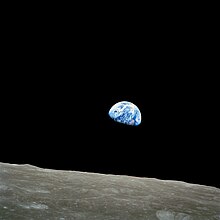CULTURAL AND HISTORICAL VIEWPOINT
The standard astronomical symbol of Earth consists of a cross circumscribed by a circle,  , representing the four quadrants of the world.
, representing the four quadrants of the world.
Human cultures have developed many views of the planet. Earth is sometimes personified as a deity. In many cultures it is a mother goddess that is also the primary fertility deity, and by the mid-20th century, the Gaia Principle compared Earth's environments and life as a single self-regulating organism leading to broad stabilization of the conditions of habitability. Creation myths in many religions involve the creation of Earth by a supernatural deity or deities.
Scientific investigation has resulted in several culturally trans-formative shifts in our view of the planet. In the West, belief in a flat Earth was displaced by the idea of spherical Earth, credited to Pythagoras in the 6th century BC. Earth was further believed to be the center of the universe until the 16th century when scientists first theorized that it was a moving object, comparable to the other planets in the Solar System. Due to the efforts of influential Christian scholars and clerics such as James Usher, who sought to determine the age of Earth through analysis of genealogies in Scripture, Westerners before the 19th century generally believed Earth to be a few thousand years old at most. It was only during the 19th century that geologists realized Earth's age was at least many millions of years. Lord Kelvin used thermodynamics to estimate the age of Earth to be between 20 million and 400 million years in 1864, sparking a vigorous debate on the subject; it was only when radioactivity and radioactive dating were discovered in the late 19th and early 20th centuries that a reliable mechanism for determining Earth's age was established, proving the planet to be billions of years old. The perception of Earth shifted again in the 20th century when humans first viewed it from orbit, and especially with photographs of Earth returned by the Apollo program.

